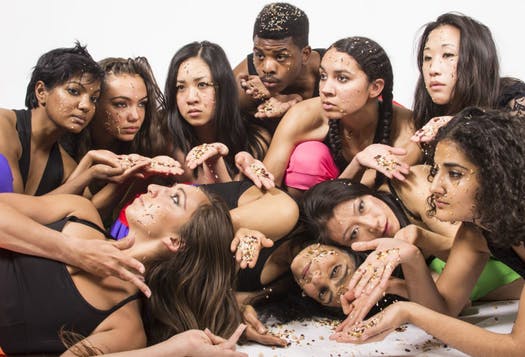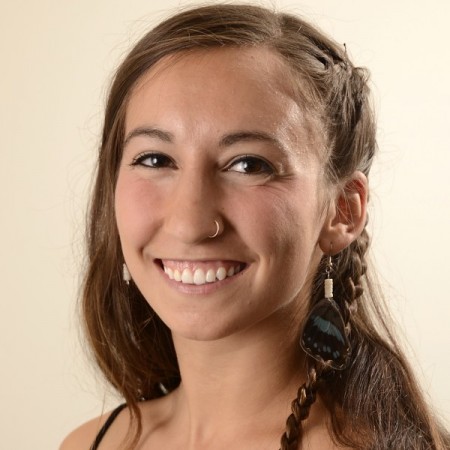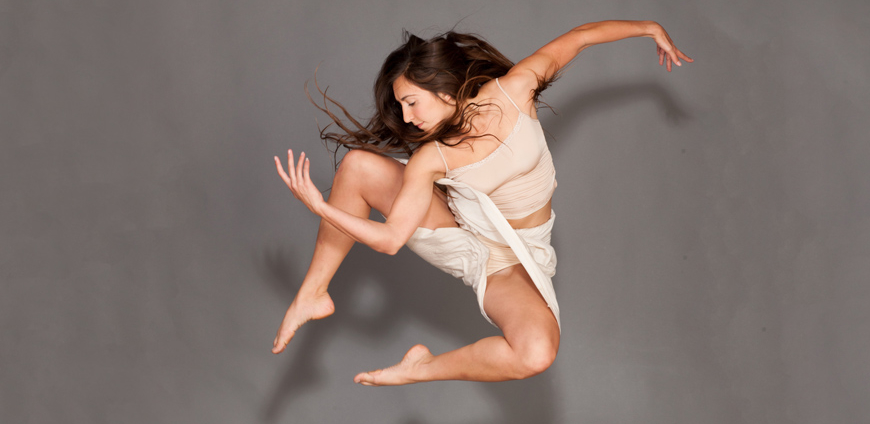Leila Awadallah dances stories of Palestine
Leila Awadallah, a 2018-2019 Springboard for the Arts 20/20 Artist Fellow, moved to Minneapolis from Sioux Falls, South Dakota to study dance before she had a sense of the kind of artist she is.
“I just knew I loved to move and express myself through movement and dance,” she laughs.
Her practice involves dance, movement, and choreography, specifically in the realm of storytelling, and particularly stories of people of color and stories from Palestine, where her family is originally from.
“I find I’m often putting myself in spaces that intersect with social justice, culture, activism, and art,” she says. “That’s where I’ve come to, though not where I began. So many people pulled my practice into activist-oriented spaces.”
One of those influential people is Ananya Chatterjea, Artistic Director at Ananya Dance Theatre, a professional contemporary Indian dance company, comprised primarily of women of color, that works within a framework of social justice. Their work links women’s stories, told through movement, with different social and cultural issues.
Through this dance theatre, Awadallah has participated in each iteration of the five-years-running series Work Women Do. Every year the series has a new focus, from land injustice to radical dreaming. These are stories of healing and trauma that, she says, has enabled her to reflect on how her practice shows up in these social justice spaces.

“They have encouraged me to activate my voice as a Palestinian American woman of color born in the United States but rooted in a different cultural space and reality,” she explains. “I started to interrogate my own identity—what does it mean to share my story of Palestinian roots, especially in the U.S. which aids Israel to expel and carry out the ethnic cleansing of my people?”
Over the last few years, Awadallah has focused her practice on spreading awareness of the occupation of Palestine and the social injustices happening there. She has also deepened her connection to her Arabic and Palestinian culture through storytelling and by engaging with the Arab arts community.
“How do we tell stories in the context of the United States where there are so many Islamophobic policies and cultural stereotypes we have to resist?” she asks. “My own work is about what’s going on in the U.S. and, in my own reflections, trying to push against these dehumanizing mainstream narratives against the Palestinian community and put that in my work.”
Awadallah says she is inspired by professor Ananya ‘s research in creating her own unique dance form Yorchha, which intersects three classical movement forms of dance, martial arts, and yoga in an entirely new form.
“That was really inspiring me to find a new way of movement making for my own creative projects,” she says. “For example, what movement do I make when I’m speaking Palestinian stories?”
As she began to consider her own movement making, she started to research different forms of Arabic folk dances, including “belly dancing” (for which, she clarifies, there are many other names that are not the “Oriental exotified” way it is described in American culture). At the same time, she also started thinking of dancing out the calligraphy of the Arabic language—learning how to write calligraphy with her body and create a new movement language.

This past summer Awadallah was able to travel to Palestine for the first time with a Jerome Foundation Travel Research grant, where she got to see her family’s home where her father was born and the city where he grew up. She visited cities she has only ever read about, studied with a Palestinian dance company, and soaked up the Arabic language anywhere it appeared, from written calligraphy to street graffiti. She researched the history but also immersed herself in the immediate voices of the people in the homeland that she tells stories about in dance.
She created her first piece after that trip with a group of seven women that explored how Arabic folk dances can celebrate the joy of culture without erasing the reality of living in a war zone amongst the struggle of violence.
“These dances are celebrations of love and femininity and connection, but also pain for home and for the loss and division of their land and violence against their land,” Awadallah explains. “They’re trying to articulate the beauty and joy of their culture, that they’re more than the war zone. There is so much culture and beauty and humanity and joy, all while suffering these huge traumas that not everyone has to go through in their lives.”
She also performed a five-hour-long solo piece at the Walker Art Museum that was just about her reflecting on the “blockage of space” in Palestine.
“Depending on where you were born and what identification you have, there’s a border and checkpoints and you can’t move around. Some people are stuck in Gaza. Some are exiled and can never come home,” she says. “This piece was built on the idea of blocking movement. With it I tried to deepen my empathetic and embodied understanding of movement being blocked. It was an intense situation for me to go through—having a U.S. passport I can travel very easily, so how can I tell these stories if I don’t experience that same kind of blockage of movement? I tried to find that through talking to people and listening to their stories and through my own embodied research and being aware of my owns privilege.”
She says that she has spent the last few months thinking about how dance often lives in a metaphoric space and how people interpret and experience it in different ways, and how that can be translated to address human rights issues. She is interested in telling Palestine stories through dance in ways that give the audience tangible information, so they would function like an informative talk.
“I want to activate the intellectual side as a lecture might do and not just evoke an emotional feeling,” she says. “I want people to leave thinking that they learned something about a situation that they didn’t know before.”

Awadallah is currently developing another solo piece that she will perform in Winona, Minnesota in January that will strive towards that goal. This show, Za’atar, will also feature two other contemporary Arab American female artists and is part of a series about Arab and Arab American culture, heritage, perceptions, and identity called the Cedar Tree Project.
However, Awadallah also acknowledges that Arab American artists should be able to create work that isn’t overtly political or identity-focused and just be artists.
“I’m trying to give myself space to be present in discourse and activate dance in its ability to speak out on issues, but also at the same time explore the artistry I have in a way that doesn’t have to always hold that weight,” she states.
She says she has lately been considering the power dance has as an energetic, transformative force to create empathy.
“We all have bodies. They can do different things and they come from different places, but we all have one. Dance is an incredible way to activate connections and movement because we have this body we’re all carrying around with us. I want to find ways to allow dance to be as powerful as it has the ability to be, to activate dance in its power to find trauma and pain and work through them to find beauty.”
As a 20/20 Artist Fellow, Awadallah plans on using this opportunity to deepen her practice and professional development by taking more professional classes in different dance forms and spending more time traveling throughout the Middle East.
“I spent some time in Lebanon two years ago and closely studied belly dance, and I was able to refine and explore my identity, so when I came back I felt that I had more of myself I could share,” she says. “I want to deepen my cross-ocean connection with myself, nurturing my cultural roots and learning more about them.”
She also hopes to spend more time engaging in dance forms that are not of the Western vernacular, including Chinese and West African forms. “As a dancer a lot of us end up in positions where we need to advocate for others, especially artists of color,” she says. “I want to learn more of the forms of dance of artists of color. How do I learn from my fellow artists of color if I’m only dancing in Western dance forms? If we don’t know how to speak about each other’s forms then we cannot advocate for them. ”

(1) How do you like to collaborate?
I don’t like to come with too much when I collaborate; I like to explore where the in-between is between people’s ideas and mediums and let them intersect as they find each other.
(2) How do you a start a project?
I tap into what is buzzing the most inside of me at the time. A lot of projects or ideas are like a buzzing; something that’s inside of me. A lot often has to do with an injustice I’m hearing about. Honestly, it comes from a place of anger that pushes me to find healing or a way to release anger and frustration.
(3) How do you talk about your value?
I think the value of dance is such an incredible way to express and tell stories using the body, using the energy that comes from movement in a way that you can express the range of vulnerability, from softness to joy to anger to strength to resistance. The body can show and express so much of these things. It resonates to create a visceral expression of these stories because it gives us a more human connection.
(4) How do you define success?
For me it’s never a sudden feeling; it comes much later when I’m able to step back and reflect on how people changed around me in a positive way. With the project I did this summer with a group of women, it didn’t hit me until months later—the power of digesting and reflecting and thinking through memories of where you’re at and how you’ve changed.
(5) How do you fund your work?
It’s usually based on an organization or a platform that has funding, then I make a project. At this point I have not sought out funding on my own yet. My work often still exists as a labor of love. If I make a solo and spend 100 hours rehearsing, I don’t get anything for that. I’m hoping as I develop my voice and craft that I will figure out how to make it more financially stable for me to produce and create work. As it is now, I’m waiting for the opportunity for a project to exist or it comes out of love and the desire to create, but I think that ends up paying itself back.
